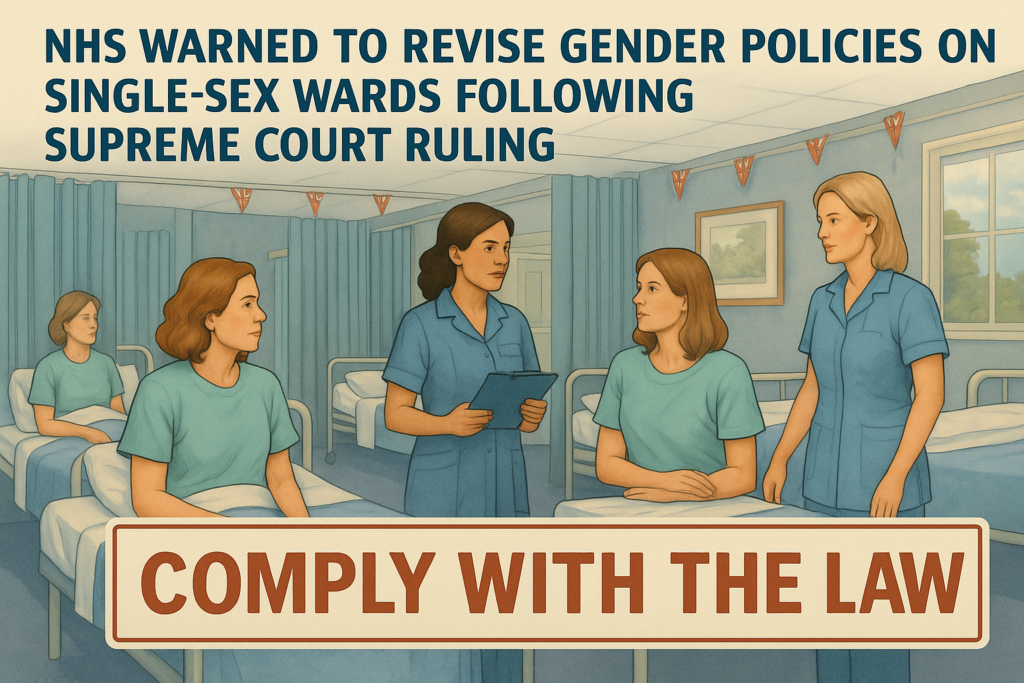The National Health Service (NHS) faces pressure to overhaul its policies on “transgender” patients’ access to single-sex wards after a landmark Supreme Court ruling clarified the legal definition of “woman” under the Equality Act 2010. The Equality and Human Rights Commission (EHRC) has issued a stern warning, urging the NHS to align its guidance with the ruling or face potential legal action. This article explores the ruling’s implications, the role of Annex B in current NHS policy, and the path forward for compliance.

Baroness Kishwer Falkner, chair of the UK’s Equality and Human Rights Commission (EHRC), said the ruling was “enormously consequential” and ensured clarity.
The Supreme Court ruling should ‘draw a line’ under debate. She vowed to pursue organisations that do not update their policies, saying they should be “taking care” to look at the “very readable judgment”.
On single-sex hospital wards, Baroness Falkner told BBC Radio 4’s Today programme the NHS will “have to change” their 2019 policy, which says transgender patients are entitled to be accommodated on single-sex wards matching how they identify.
She said the court ruling means there is now “no confusion” and the NHS “can start to implement the new legal reasoning and produce their exceptions forthwith”.
Supreme Court Ruling Redefines “Woman” in Equality Law
On April 16, 2025, the UK Supreme Court ruled unanimously that “woman” and “sex” in the Equality Act 2010 refer to biological sex, not gender identity or legal sex as defined by a Gender Recognition Certificate (GRC). This decision, prompted by a challenge from For Women Scotland against the Scottish government, allows single-sex spaces, such as prisons, and refuges and hospital wards, to exclude “transgender” women if it serves the legitimate aim of ensuring privacy or safety.
The ruling clarifies that “transgender” women, even those with a GRC, will be excluded from women-only spaces if the exclusion is deemed a “proportionate means of achieving a legitimate aim,” such as ensuring privacy, safety, or dignity. The court emphasised that “transgender” individuals retain protections against discrimination under the Equality Act’s provisions for gender reassignment, but these do not extend to accessing single-sex spaces designated for biological women.
“The unanimous decision of this court is that the terms ‘woman’ and ‘sex’ in the Equality Act 2010 refer to a biological woman and biological sex,” said Lord Patrick Hodge, Deputy President of the Supreme Court.
This landmark judgment resolves years of legal ambiguity and sets a precedent for how equality laws are interpreted in the UK, particularly in sensitive settings like healthcare.
Current Guidance and the Role of Annex B in the NHS
The NHS’s 2019 “Delivering Same-sex Accommodation” guidance, specifically Annex B, allowed “transgender” patients to be accommodated on single-sex wards based on their gender presentation—how they dress, their name, and pronouns—rather than their biological sex. This policy conflicts with the Supreme Court’s ruling, which prioritises biological sex.
Annex B defines “transgender” patients broadly, including those “whose personal experience of gender extends beyond the typical experiences of their assigned sex at birth,” and does not require a GRC or medical transition for ward placement. Critics argue this compromises the safety, privacy, and dignity of patients in single-sex wards, particularly women, as it effectively permits mixed-sex accommodation
“The result of Annex B is that hospital trusts inform ward sisters and nurses that if there is a male, as a trans person, in a female ward, and a female patient or anyone complains, they must be told that it is not true – there is no male there,” said Baroness Nicholson in a 2022 House of Lords debate.
Under the current guidance, a “transgender” woman could be placed in a women’s ward, and a “transgender” man in a men’s ward, based on their gender. The EHRC argues that this practice is not legally compliant, as it conflicts with the court’s interpretation of the Equality Act. The watchdog has called for an immediate revision to ensure wards accommodate patients based on their biological sex.
“The NHS will have to change their 2019 policy, which says transgender patients are entitled to be accommodated on single-sex wards matching how they identify,” said Baroness Kishwer Falkner, chair of the EHRC.
EHRC’s Warning and and Legal Threat for Compliance
The EHRC, tasked with enforcing equality laws in the UK, has taken a firm stance on the issue. Baroness Falkner confirmed that the commission is “working at pace” to develop an updated code of conduct for public services, including the NHS and prisons, with new guidance expected by summer 2025. This code will provide clear instructions on implementing single-sex spaces in line with the Supreme Court’s ruling.
The EHRC has explicitly stated the NHS must update its policies promptly. Falkner emphasised the urgency, noting that the commission has been in discussions with the NHS for an “inordinately long time” without sufficient progress. Baroness Falkner, EHRC chair, has confirmed the commission will pursue legal action if the NHS fails to update its guidance, including Annex B, to reflect the ruling.
“We’ve been speaking to the health service for an inordinately long time – we will now be asking them when they will be updating their advice,” Falkner told BBC Radio 4’s Today programme.
This threat of legal action underscores the EHRC’s commitment to ensuring compliance with the new legal framework, particularly in high-stakes environments like hospital wards where patient privacy and safety are paramount.
Implications for Single-Sex Wards and Patient Care
The shift to accommodating patients based on biological sex could significantly alter the patient experience in NHS hospitals. Single-sex wards, mandated by the NHS since 2010, aim to ensure privacy, dignity, and safety, particularly for vulnerable patients. However, Annex B’s allowance for gender self-identification has led to reported breaches, with over 44,000 mixed-sex ward incidents recorded in 2023, a significant rise from pre-pandemic levels. The Supreme Court’s ruling reinforces the legal basis for maintaining these spaces exclusively for biological women or men, excluding “transgender” patients from wards that align with their gender identity.
For “transgender” patients, this change may raise concerns about dignity and safety. Some fear that placing “transgender” women (men) in male wards or “transgender” men (women) in female wards could expose them to discomfort or hostility. Conversely, gender-critical campaigners, including For Women Scotland, hail the ruling as a “victory for women’s rights.” They argue that prioritising biological sex protects the privacy and safety of biological women in sensitive settings like hospital wards. Trina Budge, director of For Women Scotland, emphasised, “When we see a women-only space, it means exactly that. Just women. No men. Not even if they have a gender recognition certificate.”
The NHS now faces the challenge of balancing these competing concerns while ensuring compliance with the law. Health Minister Karin Smyth has acknowledged the need to review the ruling to ensure full compliance, stressing that the government aims to respect “everybody’s dignity and privacy and their rights.”
Broader Impact on UK Equality Laws
The Supreme Court’s ruling extends beyond the NHS, affecting other sectors like prisons, sports, and domestic violence refuges. For example, sports governing bodies have already tightened rules around “transgender” athletes, with athletics, cycling, and aquatics banning “transgender” women from women’s events at elite levels. Similarly, British Transport Police have updated their policies to conduct same-sex searches based on biological sex, reflecting the ruling’s immediate impact.
The EHRC’s forthcoming guidance will likely address these sectors, providing a unified framework for implementing single-sex spaces. However, the ruling has sparked calls for broader legislative reform. Conservative leader Kemi Badenoch has advocated for a review of equality and gender recognition laws, arguing that they need updating to reflect biological realities and prevent misinterpretation by public bodies.
Steps Forward for the NHS
To comply with the Supreme Court’s ruling and avoid legal action, the NHS must act swiftly to revise its policies, particularly Annex B, to prioritise biological sex in ward assignments, ensuring alignment with the Equality Act’s definition of “woman” and “sex.”
Key steps include:
- Revise Annex B: Amend the 2019 guidance to prioritise biological sex for ward assignments, removing provisions for gender self-identification.
- Engage Stakeholders: Consult patient groups, “transgender” advocates, and gender-critical organisations to develop inclusive solutions, such as single rooms or third-space facilities where feasible.
- Train Staff: Provide clear guidelines and training to implement policies sensitively, ensuring patient dignity.
- Align with EHRC: Collaborate to ensure compliance to ensure the updated policies meet the forthcoming code of conduct and withstand legal scrutiny.
The NHS has a delicate task ahead, as it must navigate legal obligations, patient rights, and public sensitivities. Baroness Falkner has suggested that “transgender” individuals could advocate for “third spaces” like gender-neutral facilities to address their needs without compromising single-sex spaces.
Conclusion
The Supreme Court’s ruling marks a pivotal moment in the UK’s approach to single-sex spaces, with significant implications for the NHS. The EHRC’s warning underscores the urgency for the NHS to revise its gender policies on single-sex wards to reflect the legal definition of “woman” as based on biological sex. While the ruling clarifies equality law, it also reignites debates over balancing women’s rights with transgender inclusion.
The EHRC’s threat of legal action underscores the urgency of compliance. As the NHS navigates this complex issue, it must balance legal obligations with the needs of all patients, ensuring safety, privacy, and dignity in hospital wards. The forthcoming EHRC guidance will provide further clarity, but collaboration and sensitivity will be key to implementing lasting change.
References
- Sky News. (2025, April 17). NHS must change policy on allowing trans people on single-sex wards, head of equalities watchdog says. https://news.sky.com (https://news.sky.com/story/nhs-must-change-policy-on-allowing-trans-people-on-single-sex-wards-head-of-equalities-watchdog-says-13350384)
- Reuters. (2025, April 16). In landmark ruling, UK’s top court says legal definition of woman refers to biological sex. https://www.reuters.com/world/uk/uks-highest-court-rule-definition-woman-under-equality-laws-2025-04-15/
- The Independent. (2025, April 17). NHS to be pursued if gender policies on single-sex wards don’t change, warns equalities watchdog. https://www.independent.co.uk/news/uk/politics/trans-women-nhs-supreme-court-ruling-b2734976.html
- BBC News. (2025, April 15). Supreme Court backs ‘biological’ definition of woman. https://www.bbc.co.uk https://www.bbc.co.uk/news/articles/cvg7pqzk47zo
- BBC News. (2025, April 17). NHS will be pursued if gender policies don’t change, equalities watchdog says. https://bbc.co.uk/news/articles/ce84054nqnyo[](https://news.sky.com/story/nhs-must-change-policy-on-allowing-trans-people-on-single-sex-wards-head-of-equalities-watchdog-says-13350384)
- NHS England. (2019, September). Delivering same-sex accommodation. https://www.england.nhs.uk/statistics/wp-content/uploads/sites/2/2021/05/NEW-Delivering_same_sex_accommodation_sep2019.pdf[](https://policyexchange.org.uk/publication/gender-identity-ideology-in-the-nhs/)
- Sex Matters. (2021, October 6). NHS hospitals: “single-sex” accommodation cannot be mixed sex. https://sex-matters.org/posts/updates/nhs-hospitals-single-sex-accommodation-can-not-be-mixed-sex/
- Daily Mail. (2022, April 7). NHS must protect wards for women only: Sajid Javid wades into trans row over female-only wards. https://www.dailymail.co.uk/news/article-10697587/amp/NHS-protect-wards-women-Sajid-Javid-wades-trans-row-female-wards.html
